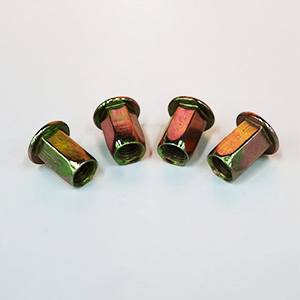Rivet nuts are commonly used in the fastening fields of various metal plates, pipes and other manufacturing industries, and are now widely used in the assembly of electromechanical and light industrial products such as automobiles, aviation, railways, refrigeration, elevators, switches, instruments, furniture, and decoration.
There are some differences in mechanical properties and calculation methods between ordinary bolts and riveted nuts. The force of high-strength riveted nuts is first to withstand external loads by applying pre-tension in them, and then friction resistance is generated on the contact surface between the connected parts ;Ordinary bolts directly bear external loads. High-strength riveted nut connections have the advantages of simple structure, good mechanical properties, detachable replacement, fatigue resistance, and no loosening under dynamic loads. This is a promising connection method. In high-strength In bolted connection, the friction coefficient has a great influence on the bearing capacity. The test shows that the friction coefficient is mainly affected by the type of contact surface and the material of the parts. In order to increase the friction coefficient of the contact surface, the contact surfaces of the parts within the connection range are often sandblasted and Wire brush cleaning. High-strength rivet nut connections rely on the friction between the contact surfaces of the connectors to prevent them from sliding. In order to make the contact surfaces have sufficient friction, it is necessary to increase the clamping force of the parts and increase the friction coefficient of the contact surfaces of the parts .
The clamping force between the components is achieved by applying pre-tension to the bolts, so the bolts must be made of high-strength steel, which is also the reason for the high-strength bolt connection. High-strength rivet nuts are tightened with a special wrench to make the bolts have Large and controllable preload. Through the nut and the backing plate, the same amount of preload is also generated on the connector. Under the action of the preload, a large friction force will be generated along the joint surface. Obviously, as long as the axial If the force is less than this friction force, the components will not slip, and the connection will not be damaged. This is the principle of high-strength bolt connection. In fact, there are two types of high-strength rivet nuts: friction type and pressure-bearing type. High-strength friction bolts bear The criterion for shear force is that the shear force caused by the design load should not exceed the friction force. The design criterion for high-strength bolts is that the shaft will not be damaged by shearing or the plate will not be crushed. Also, high-strength bolts cannot be reused.

Related News
- Types of wire drawing rivets and anti-rust methods
- What are the functions of rivets?
- How to use blind rivets
- What is a rivet nut?
- Structure introduction and maintenance of rivet gun
- Application of Lantern Rivet Nut
- Classification and application of rivet standoffs
- The working principle and selection rules of riveting gun
- Comparison of drawing rivet connection and traditional craftsmanship
- How to use blind rivets
- Precautions when using blind rivets
- Possible problems when ring groove rivets cannot be installed
- Introduction and uses of ring groove rivets
- How to prevent oxidation of rivets?
- Product overview of ring groove rivets
- How to prevent oxidation of rivets?
- The uses and operating precautions of ring groove rivets
- Why can ring groove rivets be used on vibrating screens?



